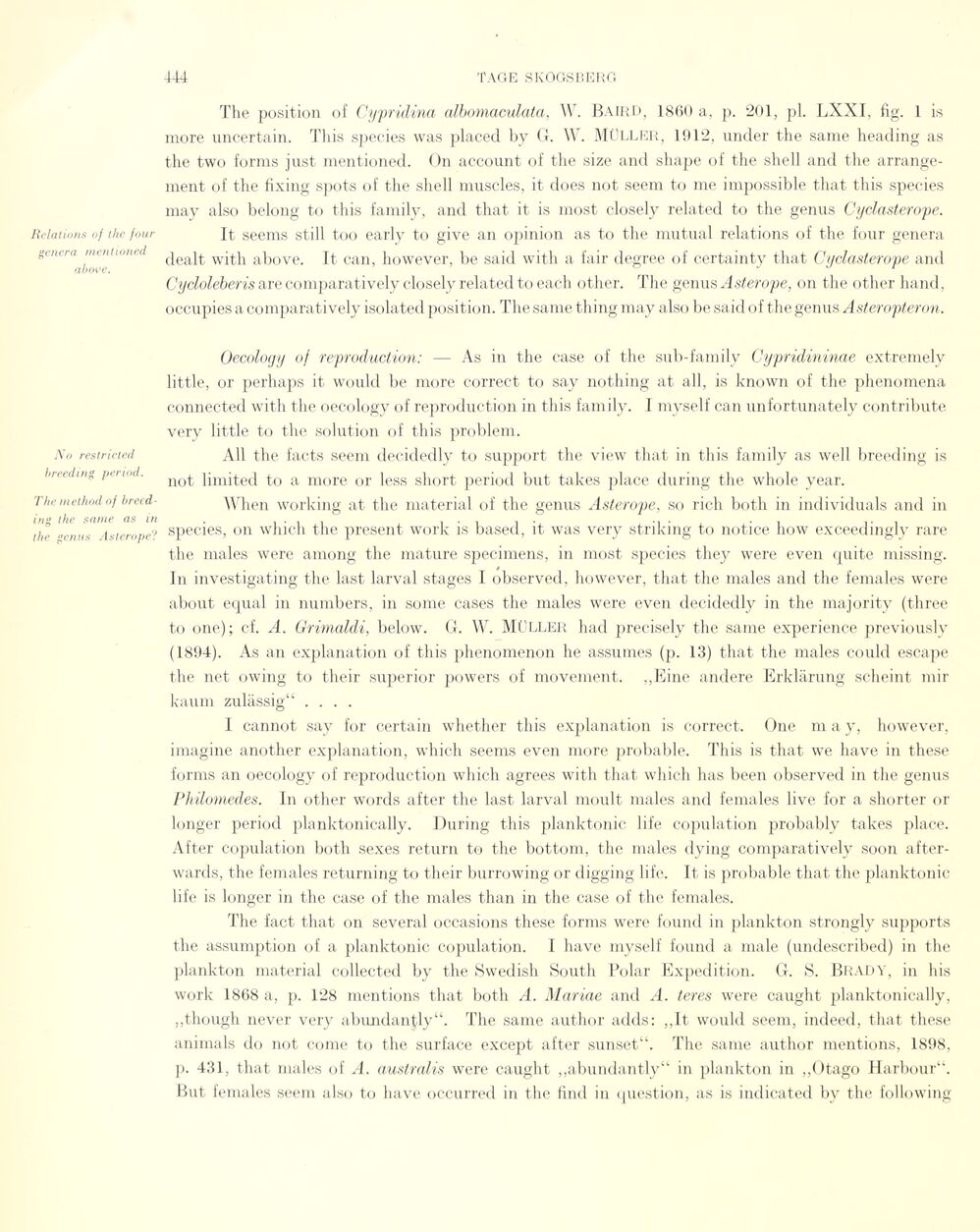
Full resolution (JPEG) - On this page / på denna sida - Sidor ...

<< prev. page << föreg. sida << >> nästa sida >> next page >>
Below is the raw OCR text
from the above scanned image.
Do you see an error? Proofread the page now!
Här nedan syns maskintolkade texten från faksimilbilden ovan.
Ser du något fel? Korrekturläs sidan nu!
This page has never been proofread. / Denna sida har aldrig korrekturlästs.
Relations oj the jour
genera rnentioned
ahove.
No restrieted
breeding period.
The melhod of
breeding the same as in
the genus Asteropel
The position of Cypridina albomaeulata, W. Baird, 1860 a, p. 201, pl. LXXI, fig. 1 is
more uncertain. This species was placecl by G. W. Müller, 1912, under the same heading as
the two forms just rnentioned. On account of the size and shape of the shell and the
arrangement of the fixing spots of the shell muscles, it does not seem to me impossible that this species
may also belong to this family, and that it is most closely related to the genus Cydasterope.
It seems still too early to give an opinion as to the mutual relations of the four genera
dealt with above. It can, however, be said with a fair degree of certainty that Cydasterope and
Cydoléberis are comparatively closely related to each o ther. The genus Asterope, on the other hand,
occupies a comparatively isolated position. The same thing may also be said of the genus Asteropteron.
Oecology of reproduction: — As in the case of the sub-family Cypridininae extremely
little, or perhaps it would be more correct to say nothing at all, is known of the phenomena
connected with the oecology of reproduction in this family. I myself can unfortunately contribute
very little to the solution of this problem.
All the facts seem decidedly to support the view that in this family as well breeding is
not limited to a more or less short period but takes place during the wliole year.
When working at the material of the genus Asterope, so rieh both in individuals and in
species, on which the present work is based, it was very striking to notice how exceedingly rare
the males were among the mature specimens, in most. species they were even quite missing.
In investigating the last larval stages I observed, however, that the males and the females were
about equal in numbers, in some cases the males were even decidedly in the majority (three
to one); cf. A. Grimaldi, below. G. W. MÜLLER had precisely the same experience previously
(1894). As an explanation of this phenomenon he assumes (p. 13) that the males could escape
the net owing to their superior powers of movement. „Eine andere Erklärung scheint mir
kaum zulässig“ ....
I cannot say for certain whether this explanation is correct. One m a y, however,
imagine ano ther explanation, which seems even more probable. This is that we have in these
forms an oecology of reproduction which agrees with that which has been observed in the genus
Philomedes. In other words after the last larval moult males and females live for a shorter or
longer period planktonically. During this planktonic life copulation probably takes place.
After copulation both sexes return to the bottom, the males dying comparatively soon
after-wards, the females returning to their burrowing or digging life. It is probable that the planktonic
life is longer in the case of the males than in the case of the females.
The faet that on several occasions these forms were found in plankton strongly supports
the assumption of a planktonic copulation. I have myself found a male (undescribed) in the
plankton material collected by the Swedish South Polar Expedition. G. S. BRADY, in his
work 1868 a, p. 128 mentions that both A. Mariae and A. teres were caught planktonically,
„though never very abundantly“. The same author adds: „It would seem, indeed, that these
animais do not corne to the surface except after sunset“. The same author mentions, 1898,
p. 431, that males of A. australis were caught „abundantly“ in plankton in „Otago Harbour“.
But females seem also to have occurred in the find in question, as is indicated by the following
<< prev. page << föreg. sida << >> nästa sida >> next page >>